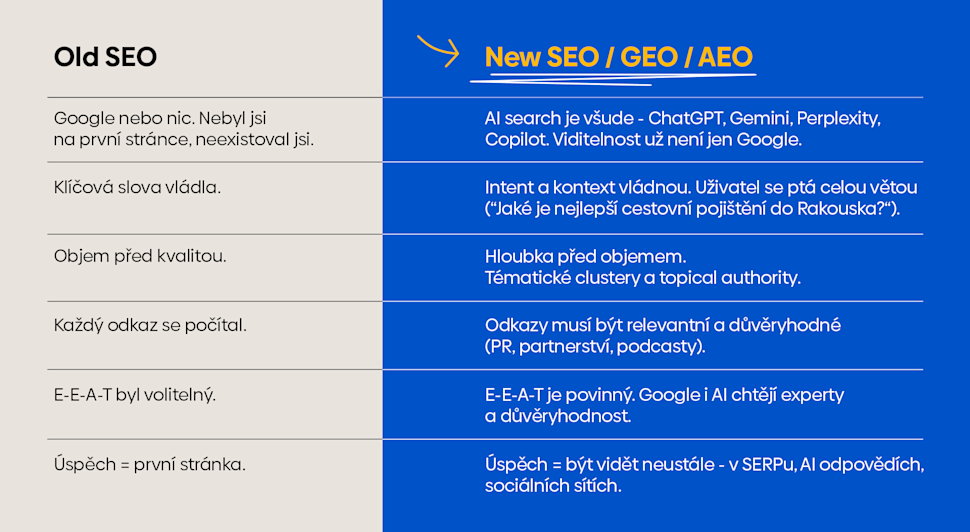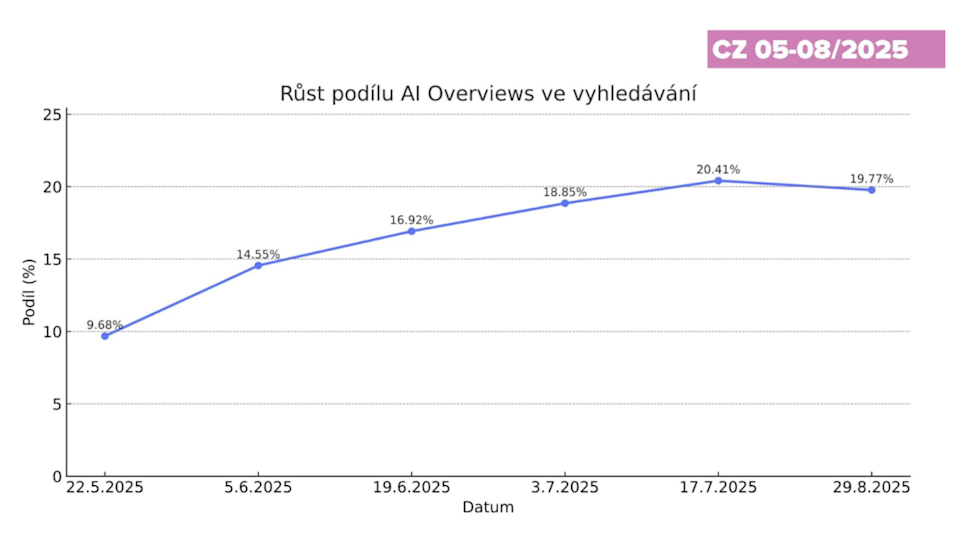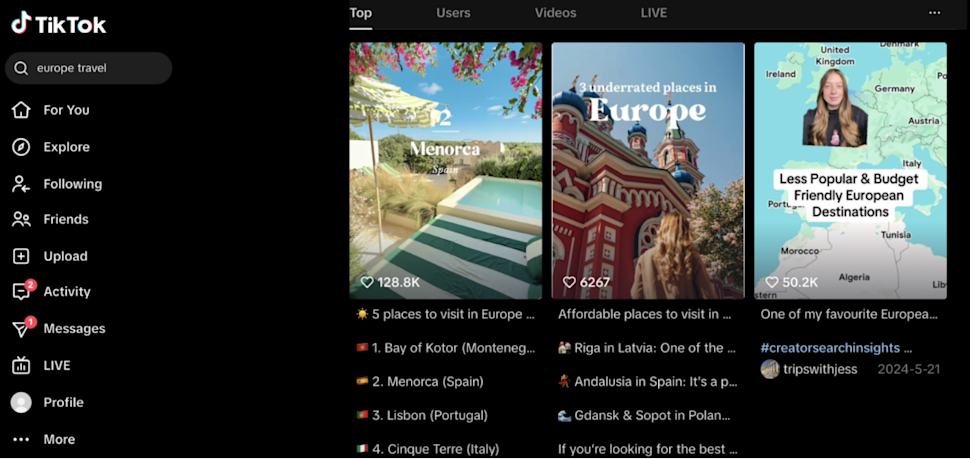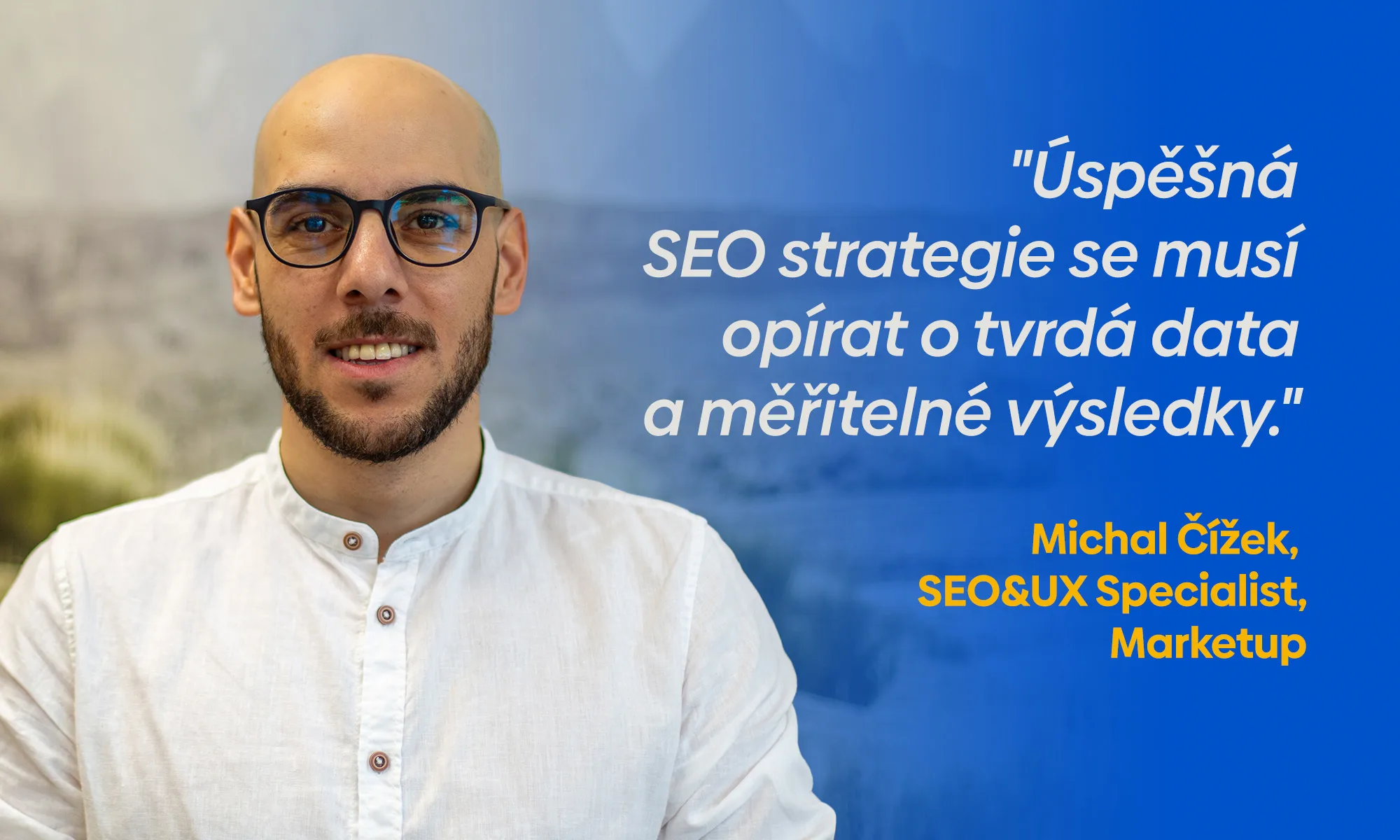Michal Čížek
12. 3. 2025
Read more


SEO is evolving at lightning speed. With AI Overviews, GEO, and AEO redefining the rules and transforming user behavior, the big question is: how do you keep your brand visible in search?
SEO isn’t dead. Its rules are just changing.
In marketing, we’ve been hearing phrase SEO is dead for years — with the arrival of Panda, Penguin, the mobile-first index, and Core Web Vitals. In 2025, it’s resurfacing once again, this time with the rise of AI Overviews and generative search.
The reality, however, is different: SEO is very much alive, it’s just evolving. We’re no longer focused solely on rankings in Google, but also on whether AI engines like ChatGPT, Gemini, Copilot, or Perplexity will cite our content. This has given rise to a new discipline — GEO (Generative Engine Optimization). As Grégory Florin aptly puts it: “SEO is like the base of an iceberg — without it, GEO could not exist.” Or, to put it more simply: GEO is SEO on steroids.

Image source: AI/Grégory Florin
Key Terms Explained
👉 SEO (Search Engine Optimization) – the classic optimization for search engines (Google). It covers the technical setup of a website, content, UX, and authority. The goal is to increase visibility in the SERP and attract relevant traffic.
👉 GEO (Generative Engine Optimization) – optimization for generative AI search engines (ChatGPT, Gemini, Copilot, Perplexity). The aim is for AI to recognize your content as trustworthy and cite it in its responses.
👉 AIO (Artificial Intelligence Optimization) – a broader strategy for optimizing content for artificial intelligence in general. It’s not only about search but also about ensuring that content is readable and usable across AI models and tools.
👉 AEO (Answer Engine Optimization) – an approach focused on providing direct answers. Originally known from featured snippets and voice search, it’s becoming even more relevant in the era of generative AI.
👉 LLM (Large Language Models) – the large-scale language models that power today’s AI applications. Examples include ChatGPT, Gemini, Claude, or Perplexity; they use LLMs to interpret queries and generate responses.
👉 AI Overviews – Google’s new feature that blends traditional search results with generative answers. Users get a summarized response directly in the SERP, without needing to click through to websites.
Old vs. New SEO

How is AI changing the way people search?
Users no longer search the way they used to. While on Google they type short phrases such as “travel insurance Austria”, in AI engines they ask full questions like “What is the best travel insurance for Austria?” This marks a fundamental shift. It’s no longer just about keywords, but about meaning, intent, and the quality of the answer. Content must therefore be written so that both humans and machines can understand it — clear, structured, and with a direct answer.
Data confirms this trend. According to Highervisibility (2025), Google’s share of overall search dropped from 73% to 66.9% in just six months, while ChatGPT has already gained a 12.5% share. The Wall Street Journal (2025) further reports that AI search now accounts for 5.6% of desktop traffic in the U.S. — double compared to the previous year.
From an SEO perspective, it’s crucial to distinguish between different types of queries:
Navigational queries (e.g., “ČSOB travel insurance”) – still dominant in Google, but AI can also suggest alternative brands. This makes brand building essential.
Informational queries (e.g., “What does travel insurance for Austria cover?”) – often answered directly by AI in overviews, leading to zero-click behavior. Here, topical domain authority and clearly structured answers are decisive.
Transactional queries (e.g., “cheapest Austria travel insurance online”) – still generate clicks and conversions in Google, but AI engines already recommend specific products. This means that e-shops and services must optimize for both SERP and AI environments simultaneously.
New Metrics: Traffic Isn’t Enough
Just a few years ago, SEO success was measured mainly by organic traffic and Google rankings. Today, these metrics are no longer sufficient. User behavior is shifting, AI search is growing, and many queries now end directly in AI overviews — without a click to the website.
This has several key implications:
Decline in organic traffic – users get answers directly from AI, reducing CTR from traditional results.
Growth of branded searches – brand strength becomes a critical driver of both traffic and conversions.
New KPI: visibility in AI engines – it’s no longer enough to rank in Google’s top 3. Companies must track whether they are cited by ChatGPT, Gemini, or Google AI Overviews.
Brand authority and E-E-A-T – link building is no longer just about backlinks. Mentions in relevant media, strong PR, podcasts, and partnerships are what build trust in the eyes of both AI and users.

Image source: Marketing Miner/Ungr
Data backs up this shift. According to Ahrefs (2025), CTR on top SERP positions has dropped by as much as 34%. Avinash Kaushik further shows that AEO traffic (Answer Engine Optimization) achieves conversion rates 4–9× higher than standard Google organic. In one tested case, as much as 12% of all registrations (leads) came directly from the AEO channel (LinkedIn).
Social Media and Video as Search Engines
SEO today goes far beyond Google. According to Metricool (2025), nearly 40% of Gen Z now use TikTok or Instagram instead of Google as their primary source of information. This fundamentally changes how people search. YouTube also remains one of the most widely used platforms — with more than 2.7 billion monthly active users (June 2025), it is officially the second-largest search engine in the world.
Content format plays a critical role. Users no longer want to read long articles — they expect quick, clear answers in video formats such as TikTok, Instagram Reels, and YouTube Shorts. If a brand is missing from these channels, it practically doesn’t exist for a large part of the audience.
The implication is clear: future content strategies cannot rely on text alone. They must be multi-format — a combination of articles, videos, and short-form social content. Brands that master this transition will not only be more discoverable to users, but also more likely to be cited by AI tools, which are already pulling information from diverse channels.

Image source: Metricool.com
Trends We Need to Watch
Zero-click dominance – users increasingly get their answers directly in the SERP or within AI overviews, leaving them with no reason to visit a website.
AI citation race – in the era of generative search engines, the race is about who AI chooses as a source. Only brands with sufficient authority, credibility, and well-structured content make it into the answers. If ChatGPT or Gemini don’t cite you, you practically don’t exist for users — even if you rank well in Google.
E-E-A-T as a requirement – what used to be a recommendation is now a baseline necessity. As Search Engine Land (2025) notes, both AI engines and Google evaluate content quality far more strictly, favoring texts with a clear author, authoritative sources, and proven expertise.
Monitoring AI results – it’s no longer enough to track rankings in the SERP. We need new tools and reporting that show whether a brand appears in AI Overviews or is cited by ChatGPT and Gemini. Monitoring competitors in these environments is equally critical.
Social SEO and video content – TikTok, YouTube, and Reels are not just entertainment platforms but the search engines of a new generation. Brands without video content risk becoming invisible to a large portion of their audience.
Content Portfolio Strategy – as Avinash Kaushik emphasizes, the future belongs to diversified content. It’s not enough to publish blog posts. Brands must be present across multiple formats (text, video, podcasts, short-form content) and on several platforms simultaneously. Most importantly, they must publish consistently, as users expect fresh and up-to-date content.
Conclusion: Google Remains Key, but AI Won’t Wait
In 2025, Google is still the most widely used search engine. However, optimizing for Google alone is no longer enough. The game has expanded: SEO + GEO + AEO + social media + video + brand. Those who fall behind for a year or two will find the competition impossible to catch. Website optimization today means being present everywhere people search - in Google, in AI tools, and on social media.
Sources Used
Marketing Miner, Reshoper 2025 – analysis of the impact of AI Overviews on 6M keywords in the Czech Republic
Ahrefs (2025) – data on CTR drop in the SERP for AI-related queries, up to 34%
MAM.cz (33/2025) – interview with SEO specialists on the impact of AI Overviews
Kevin Indig (Ahrefs Podcast, 2025) – AI citations and differences between Google and ChatGPT
Chris Donnelly (LinkedIn, 2025) – Old SEO vs. New SEO framework
Grégory Florin (LinkedIn, 2025) – the metaphor “SEO as the foundation of GEO”
Avinash Kaushik (LinkedIn, 2025) – AEO strategy, conversion rates of AEO traffic
Search Engine Land (2025) – E-E-A-T as a mandatory standard for both SEO and AI
Metricool (2025) – over 40% of young users search primarily on TikTok or Instagram
Future AI Sentiment Wave 3 (Tom’s Guide, 2025) – 55% of users in the U.S. and 62% in the U.K. prefer AI over Google
Wall Street Journal (2025) – AI search accounts for 5.6% of desktop traffic in the U.S., double compared to 2024
The Guardian (2025) – AI Overviews caused up to an 89% drop in organic traffic for some publishers
Wikipedia (2025) – description of the function and risks of Google AI Overviews
SQ Magazine (2025) – 43% of U.S. teenagers use TikTok as their main search tool, Reels make up 41% of Instagram time
Global Media Insight (2025) – YouTube statistics


